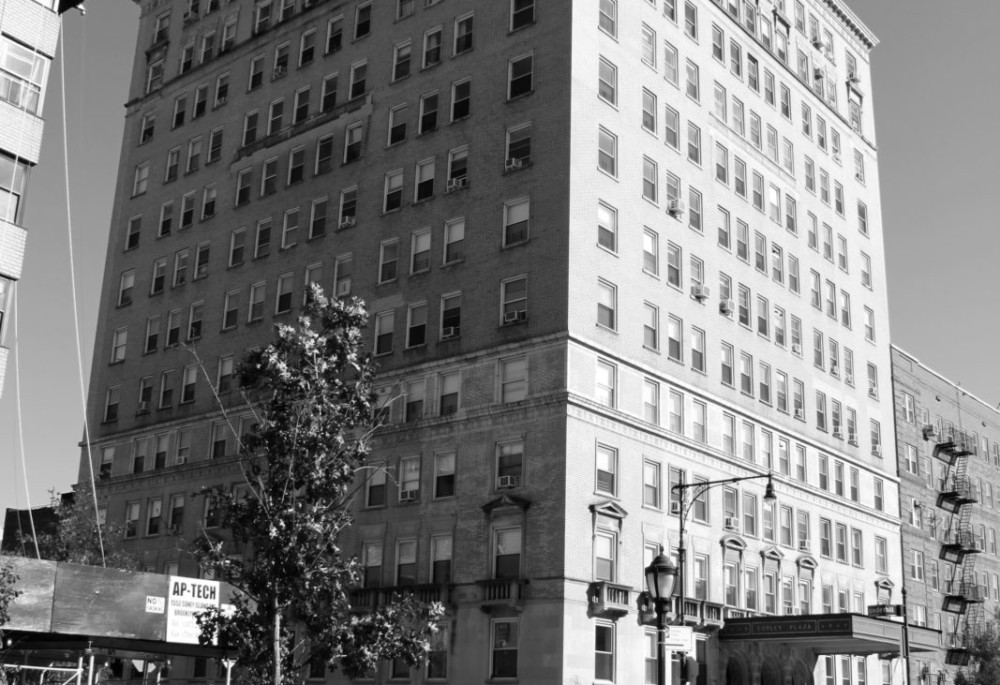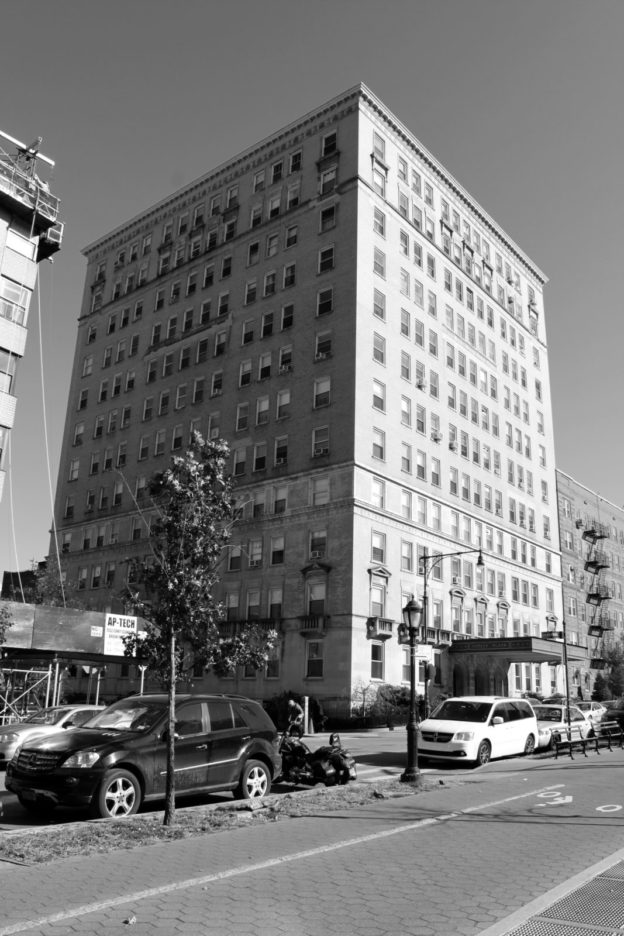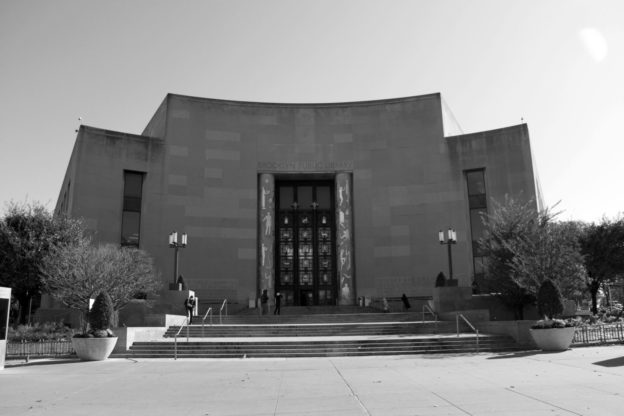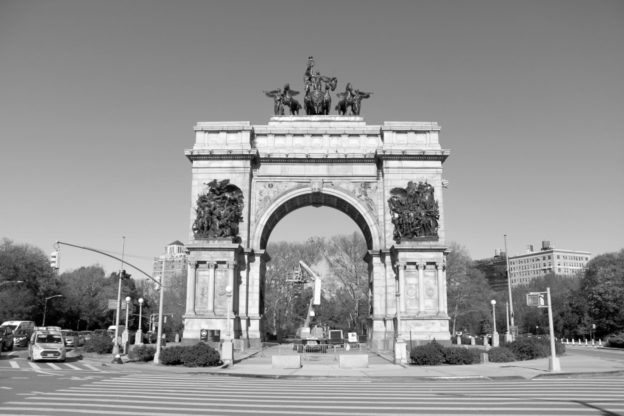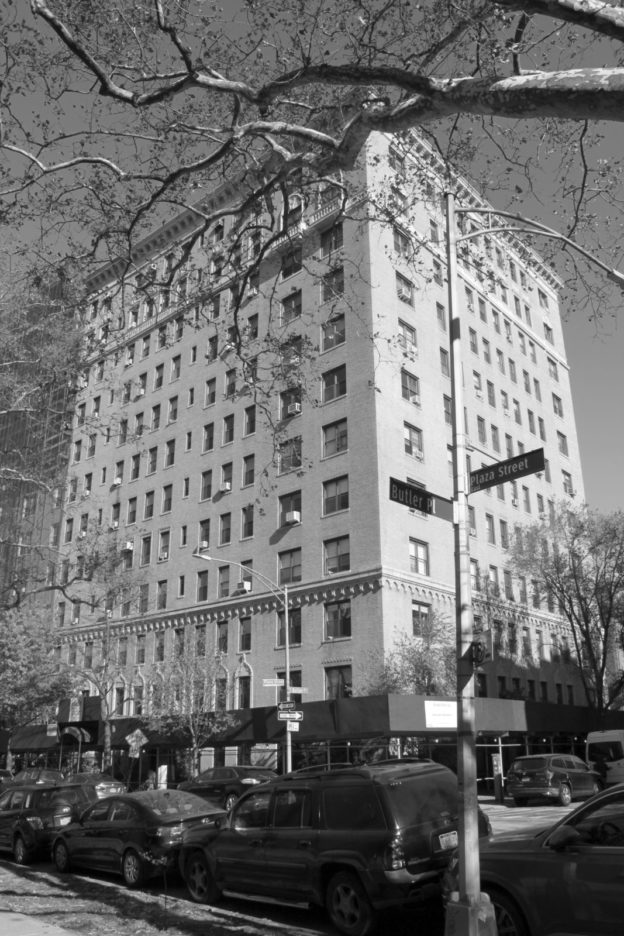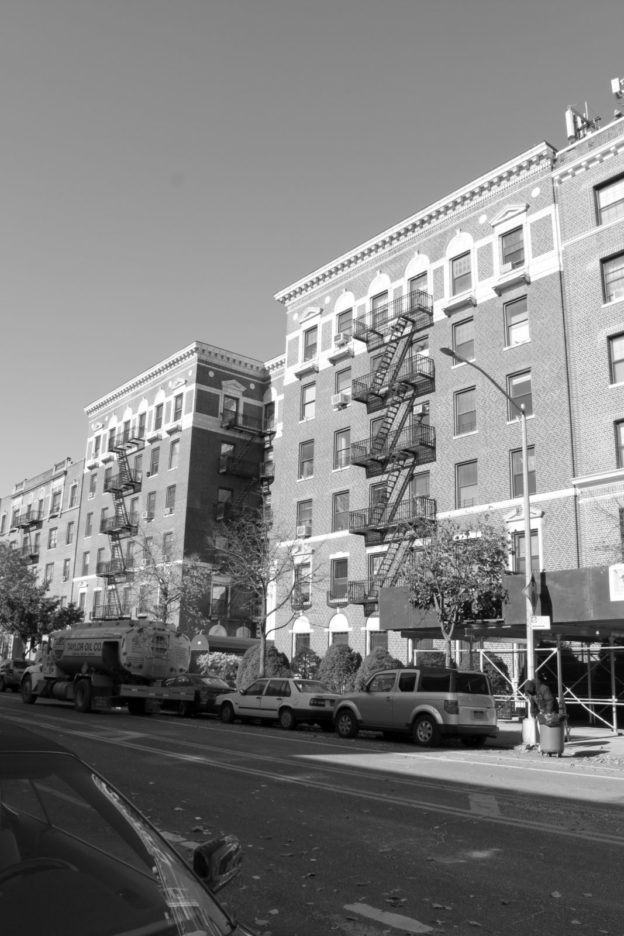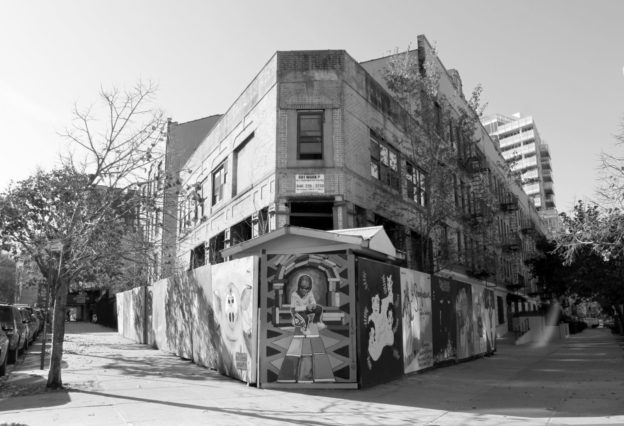41 Eastern Parkway
1926
Shampan & Shampan
This 12-story apartment building may be the stateliest apartment building on Eastern Parkway. Though it is sheathed from top to bottom in beige brick, with touches of terra-cotta trim, it sports an unusually emphatic wood and metal canopy over a triple-arched entrance, with three double-doored doorways, in an extravagant surround of vermiculated limestone and elaborate terra- cotta moldings. A quartet of splendid lanterns completes the beautiful composition, which for sheer luxuriousness may have no match in Brooklyn.
The brothers Joseph and Louis Sampan formed their firm in Brooklyn in 1907. Their credits include the nearby Colony House (225 Sterling Place, 1937), the Rulian at 295 St. John’s Place (site 7), and 14-34 Butler Place (site 11), and the exceptional Temple Beth El (15th Ave., Borough Park, 1920-23), one of the grandest synagogues in New York City. In 1930, rents ranged from $1,200 to $5,600 a year. That’s equivalent to $1,500 to $7,000 a month today.
1937-41
Githens & Keally
In 1908, the Brooklyn-born, École des Beaux-Arts-trained architect Raymond Francis Almirall was commissioned to design a central library in an elaborately classical style to complement the Brooklyn Museum to its east and the Soldiers’ and Sailors’ Memorial Arch to its west. Alas, in 1913, following excavation of the foundation and the beginnings of construction, the project was halted for lack of funds. Work did not resume until 1937, at which time Alfred Morton Githens and Francis Keally, making use of Almirall’s footprint, gave us a monumental library that may be termed either Art Moderne or stripped classical. Sheathed in Indiana limestone, its sweeping concave façade relates beautifully to the plaza it faces. The entrance is adorned with gilded reliefs by Carl Paul Jennewein, and a metal screen by Thomas Hudson Jones, bearing charming images drawn from literature. Inside, the wood-walled catalogue room, recalling the work of the Swedish architect Erik Gunnar Asplund, is one of the finest monumental interiors in the city, if not the country. The Brooklyn Public Library is a NYC Individual Landmark and listed on the State and National Register of Historic Places.
17 Eastern Parkway
1925
Arnold W. Brunner Associates
The Union Temple House was an eight-story building to be constructed next to a synagogue that was never built. The design was a classical- style structure that would have complemented Raymond Almirall’s Brooklyn Public Library and the Soldiers’ and Sailors’ Memorial Arch to bring classical grandeur to this end of Eastern Parkway. The project was never executed, and the land remained vacant until 2008, when Richard Meier designed and built 1 Grand Army Plaza.
1889-92
John Hemenway Duncan
The bronze quadriga, The Triumphal Progress of Columbia, by Brooklyn-born Frederick W. MacMonnies, was installed in 1898, followed in 1901 by MacMonnies’s The Army: Genius of Patriotism Urging American Soldiers on to Victory. The spandrel sculpture is by Philip Martiny, and the inner walls of the arch are graced by bronze reliefs bearing equestrian portraits of Abraham Lincoln (the only known equestrian depiction of the sixteenth president) and of Ulysses S. Grant, by Thomas Eakins and William R. O’Donovan. Architectural historian Henry Hope Reed said this is the “finest triumphal arch of modern times, second only to the Arc de Triomphe in Paris,” and one of America’s greatest works of art. The Soldiers and Sailors Memorial Arch is a NYC Individual Landmark and listed on the State and National Register of Historic Places.
1932
Egerton Swartwout, architect, Eugene Savage, sculptor
This wonderful fountain–one of too few elaborate fountains in New York City–is located in the secluded oval, thickly framed by trees, directly to the north of the arch. It is a riot of extravagant, grotesque figuration and mythological and allegorical allusion. Bronze figures of a man and a woman representing Wisdom and Felicity form the centerpiece, though a fantastically surly Neptune steals the show. The Bailey Fountain is listed on the State and National Register of Historic Places.
1916
Shampan & Shampan
This row of four-story apartment buildings features ground floors faced in light stone yielding to light-hued brick above. There is well-executed classical ornamentation, Juliet balconies with their original iron railings, and, best of all, the original cornices.
36-50 Plaza Street East
1925
Sugarman & Berger
These 12-story apartment buildings are in the classic New York style of their era, with limestone-fronted ground floors yielding to modestly ornamented brick shafts rising to strong cornices. As is appropriate on the oval of Plaza Street, the buildings have subtly concave façades.
60 Plaza Street East
1939-40
Philip Birnbaum
This striking Art Moderne apartment building is contemporary with the Central Library (1937-41), and is in a similar style, injecting a note of midcentury modernity that is nonetheless compatible with its classically designed neighbors. The exceptionally wide (211 feet) building follows the curve of Plaza Street and echoes it in the gently curved corner cantilever balconies. Philip Birnbaum (1907-96) was one of the most prolific apartment building architects in New York history. He attended Stuyvesant High School and Columbia University, and his many credits range from the lushly landscaped Forest Hills South development in Queens, to One Lincoln Plaza (1971) on Broadway and 63rd Street. He also designed the nearby Vanderbilt Plaza (1956) at 34 Plaza Street.
295 St. John’s Place
1923-24
Shampan & Shampan
Built by the Rulian Construction Company, this six-story building has a façade of Vermont marble, terra cotta, and brick laid in a diamond pattern. The Rulian is 150 feet wide on St. John’s Place, with a recessed central section that features a long cloth canopy extending from an entrance set within the lower of two stories faced in marble. The materials and the discrete classical details make this one of the most elegant buildings in the district. It is neatly flanked by the Vernona (285 St. John’s Place, 1924) and the Belnord (315 St. John’s Place).
